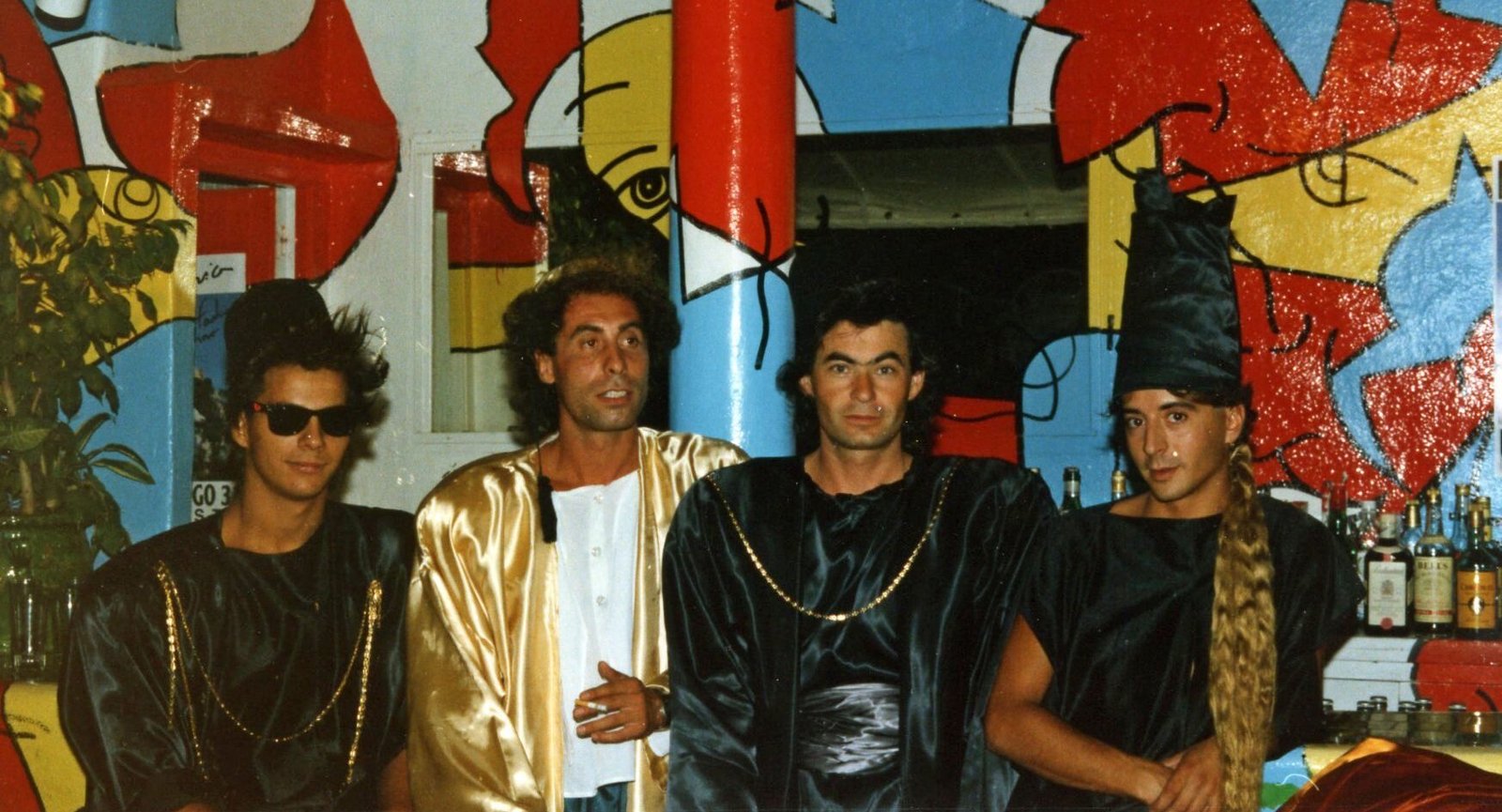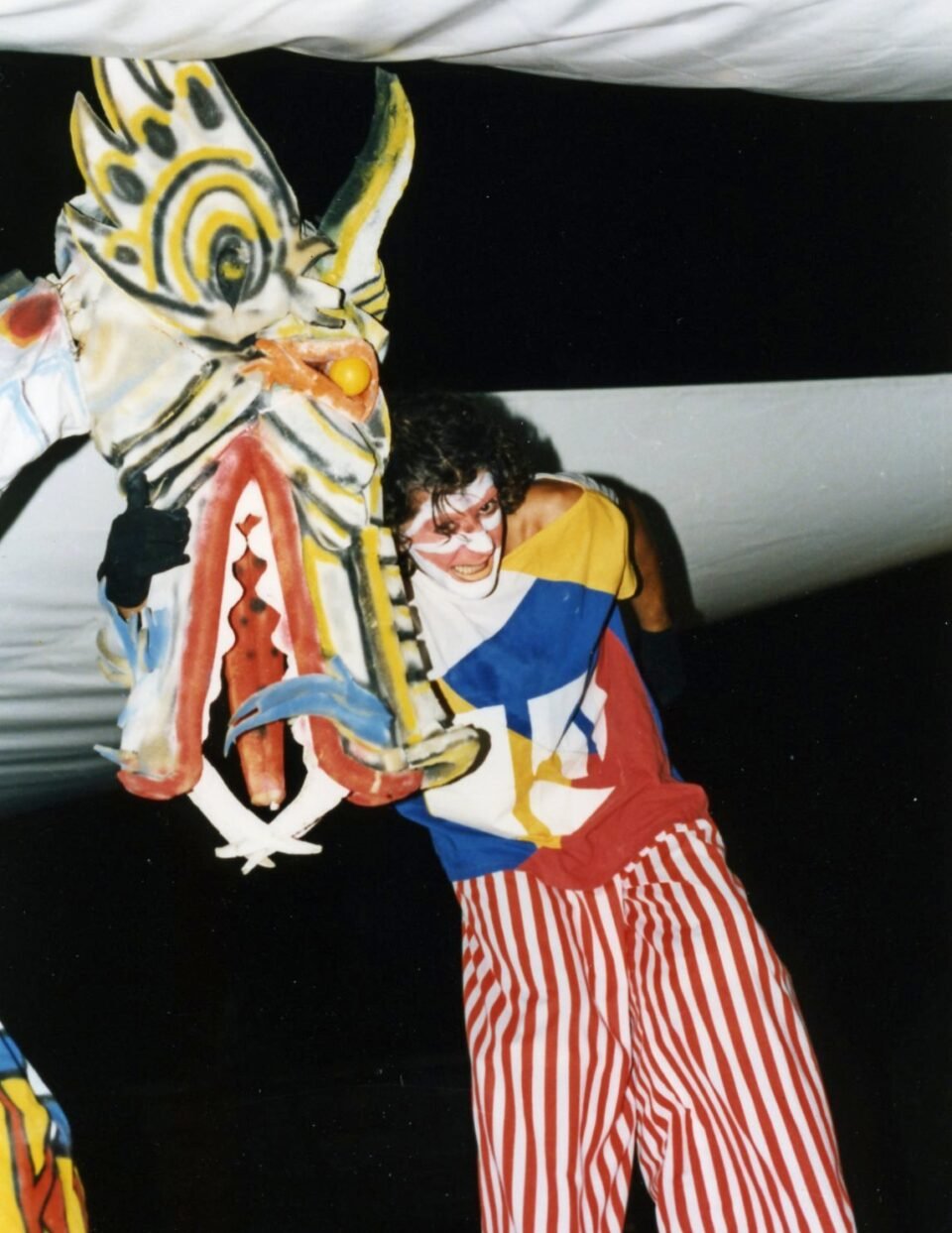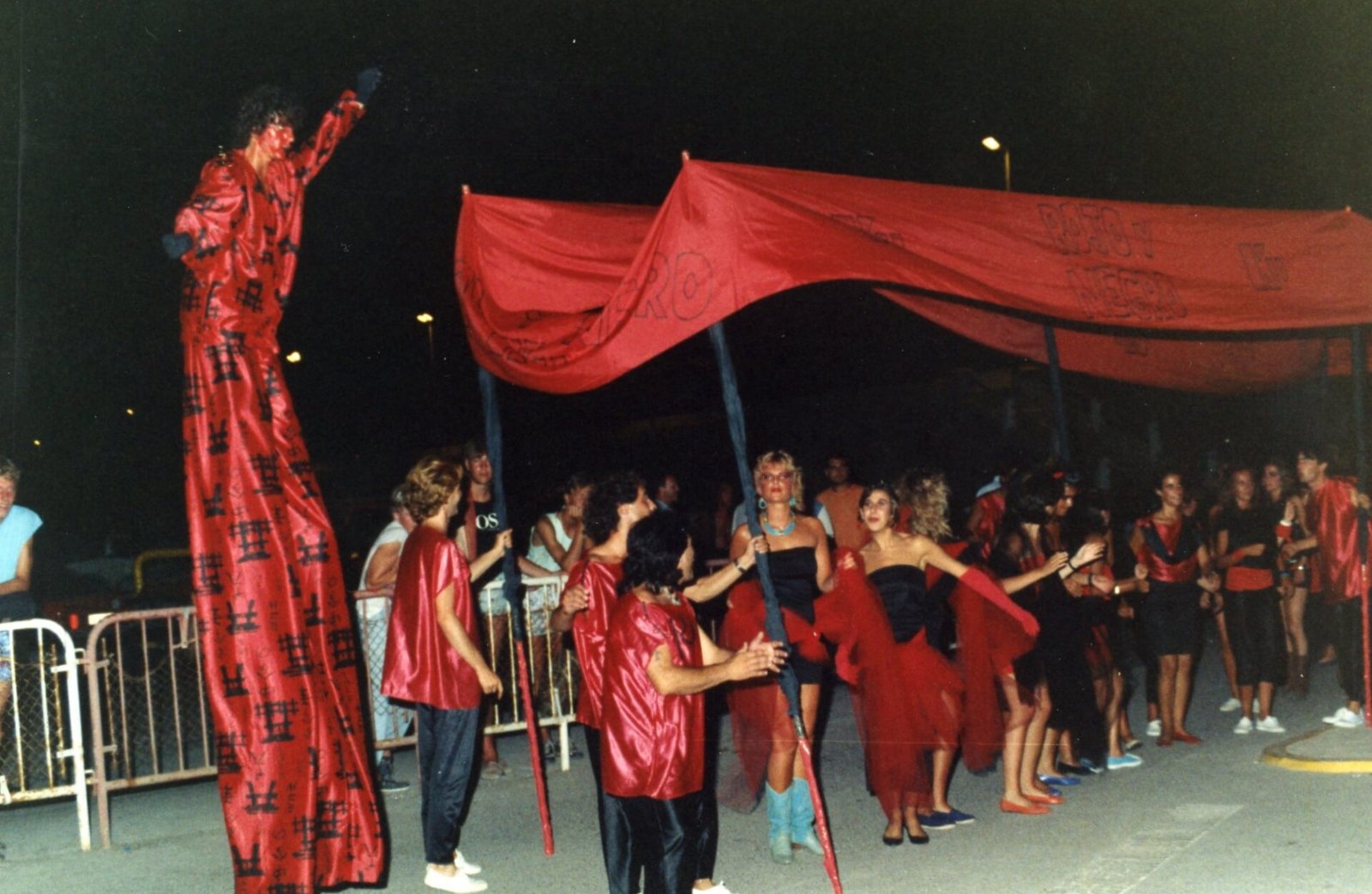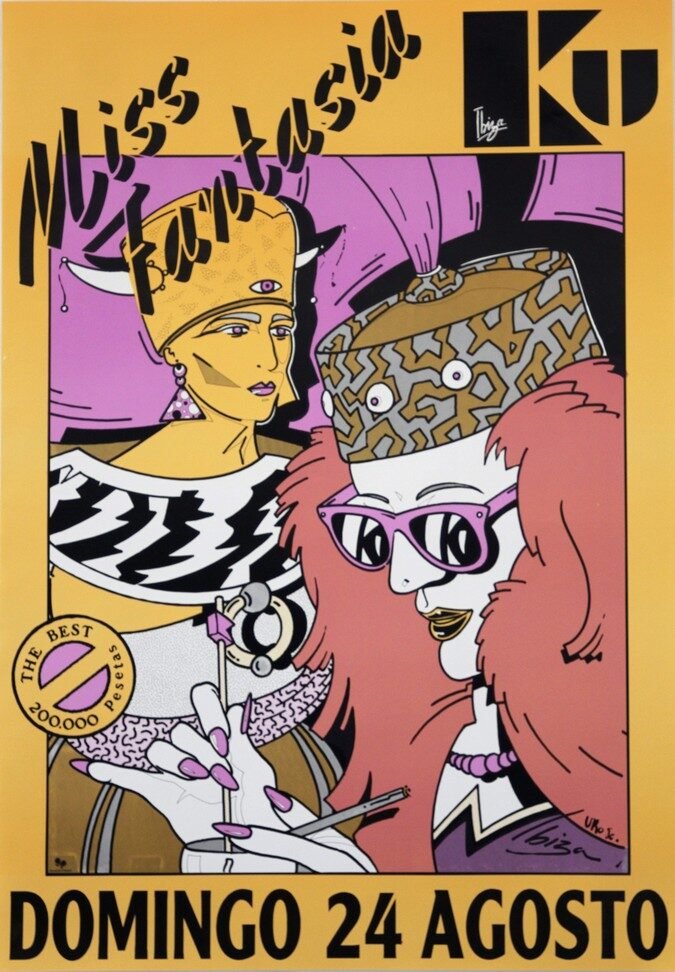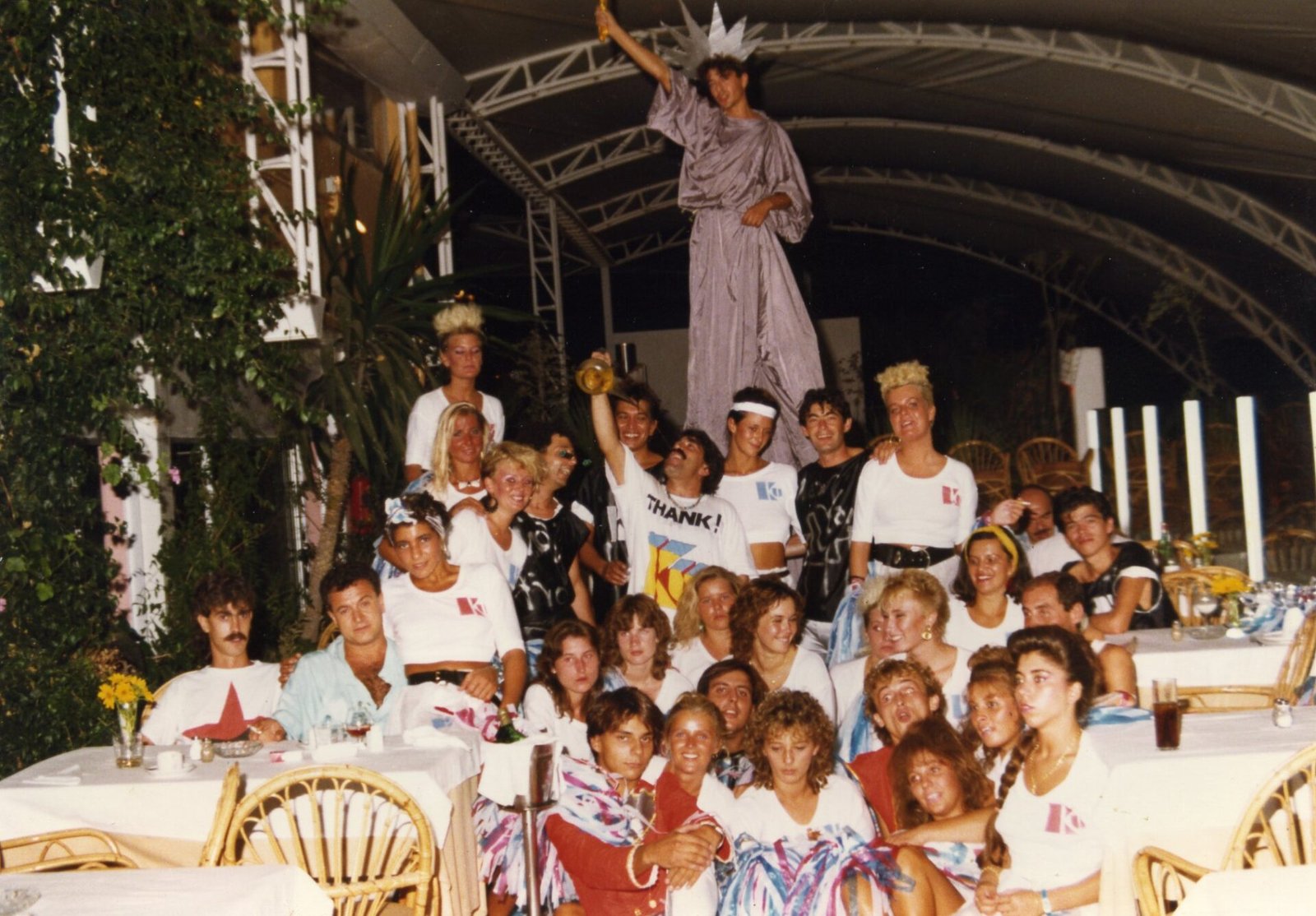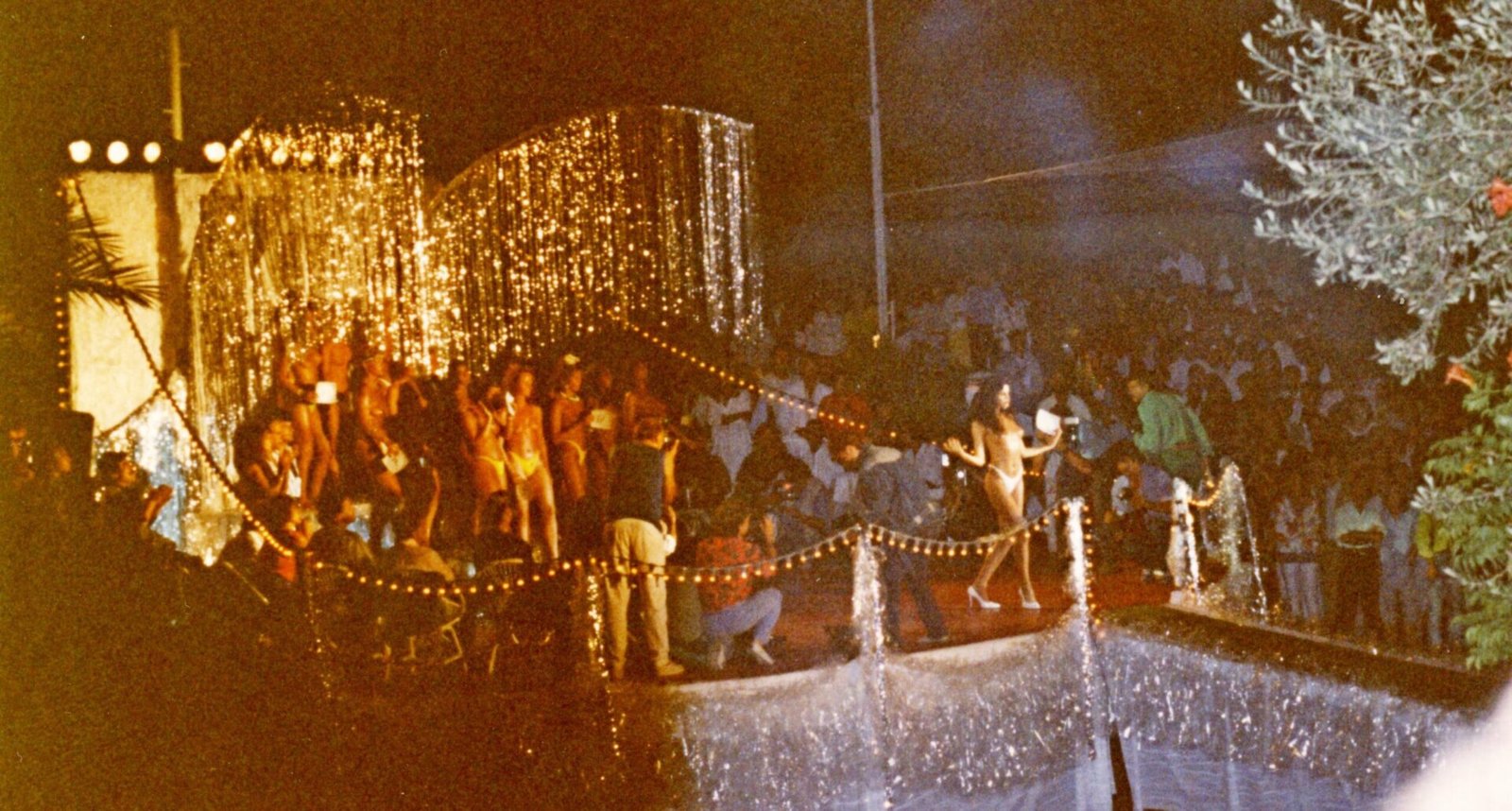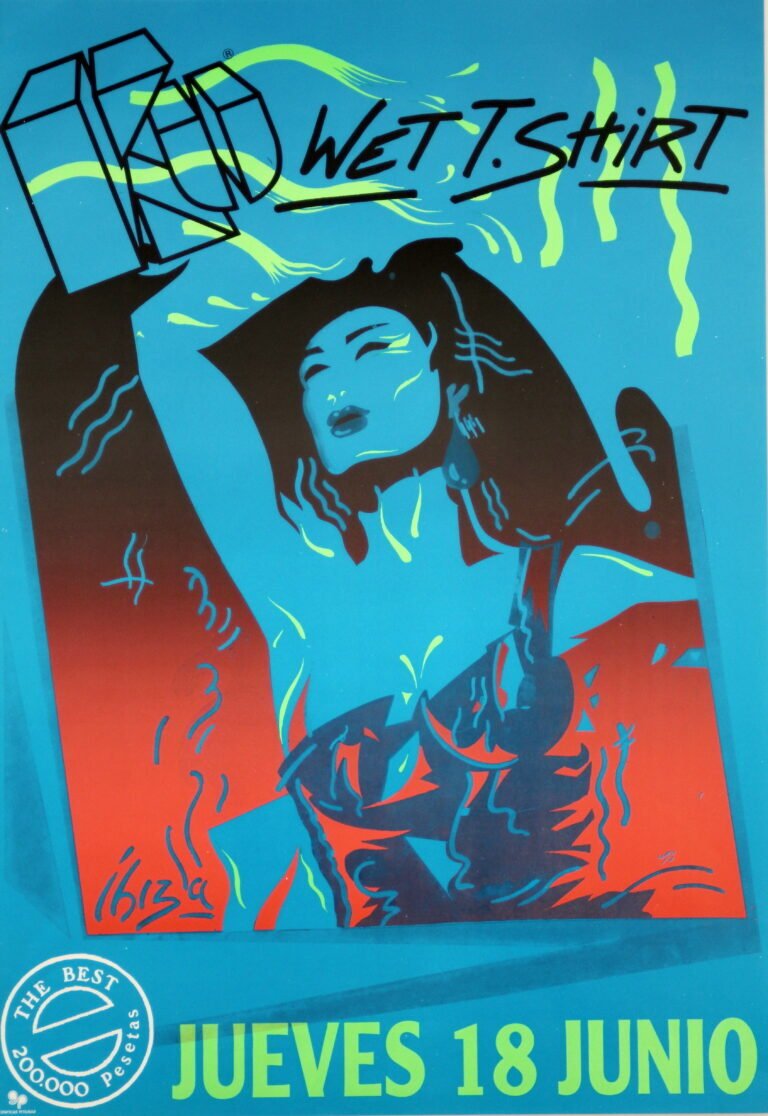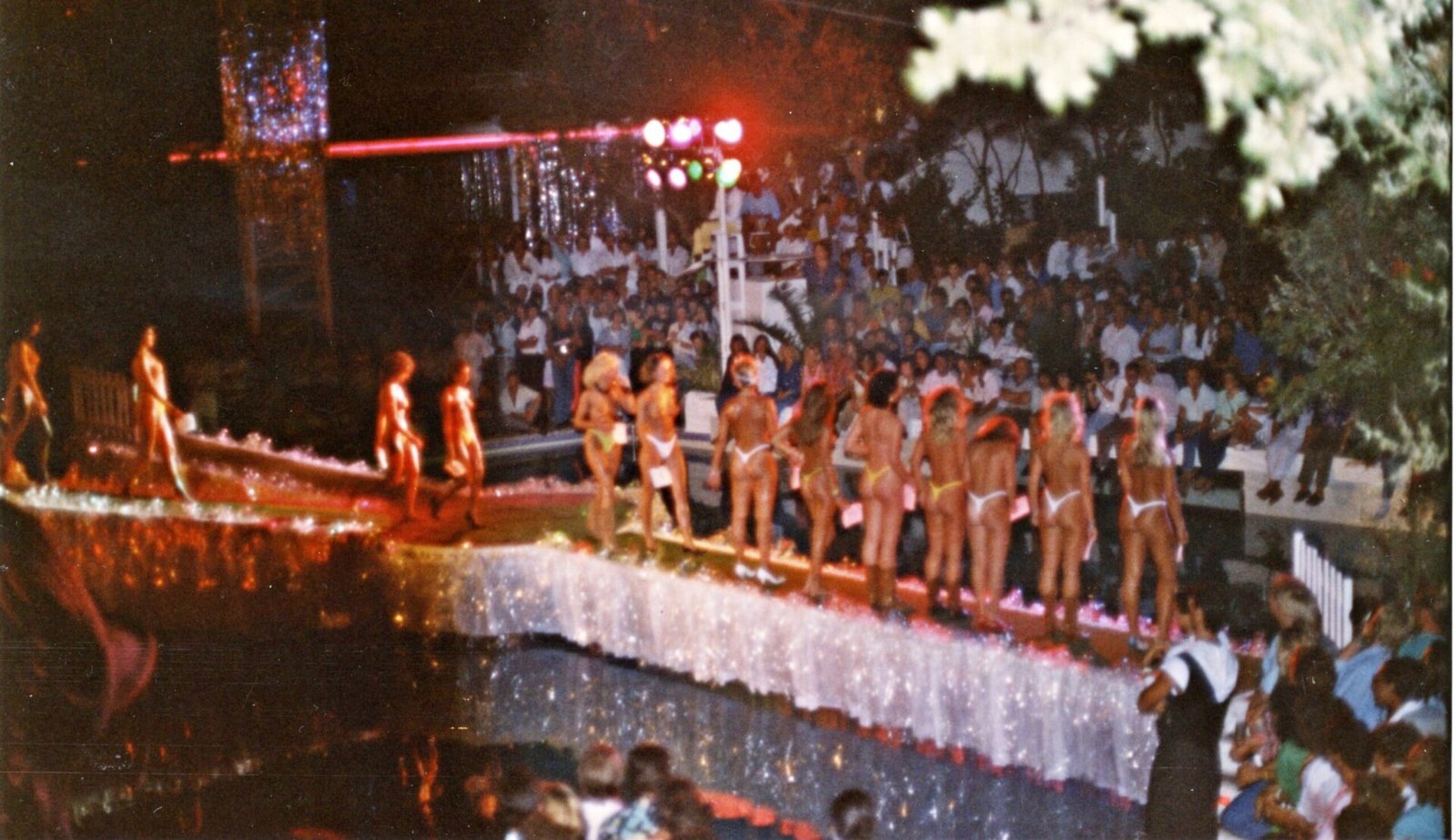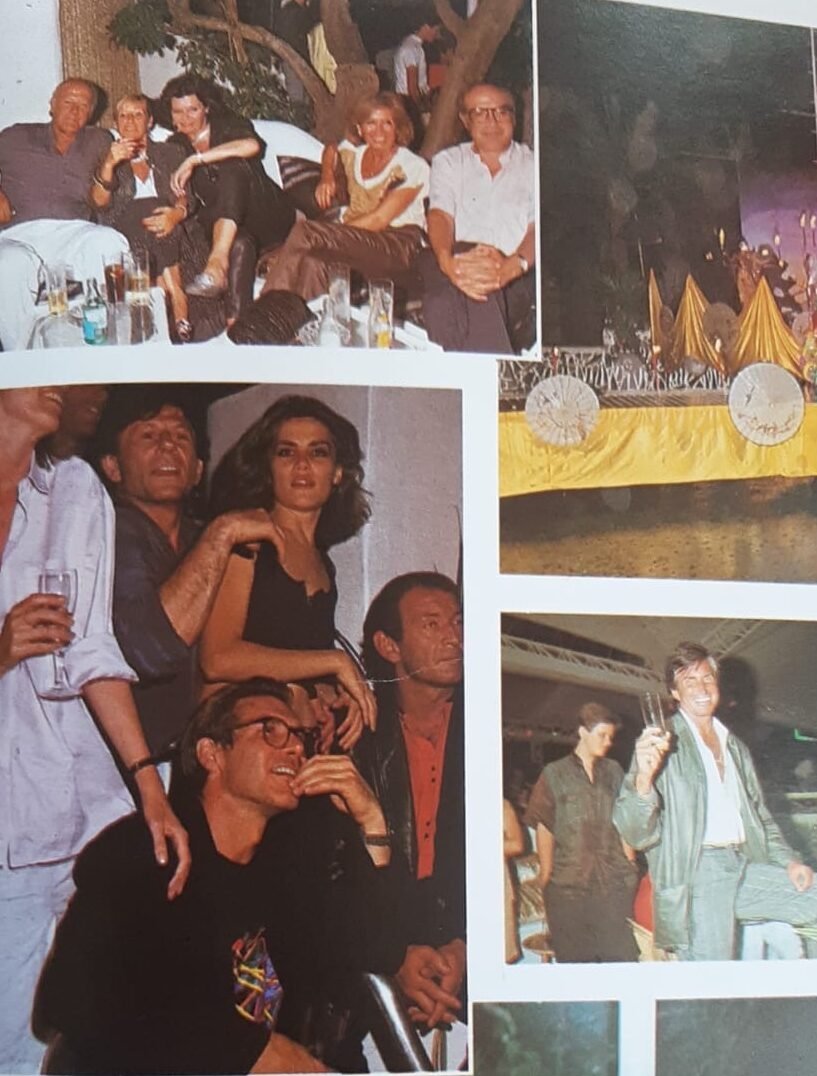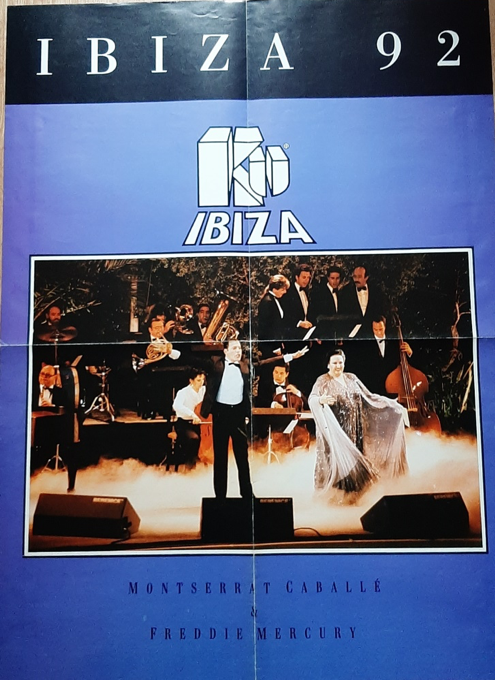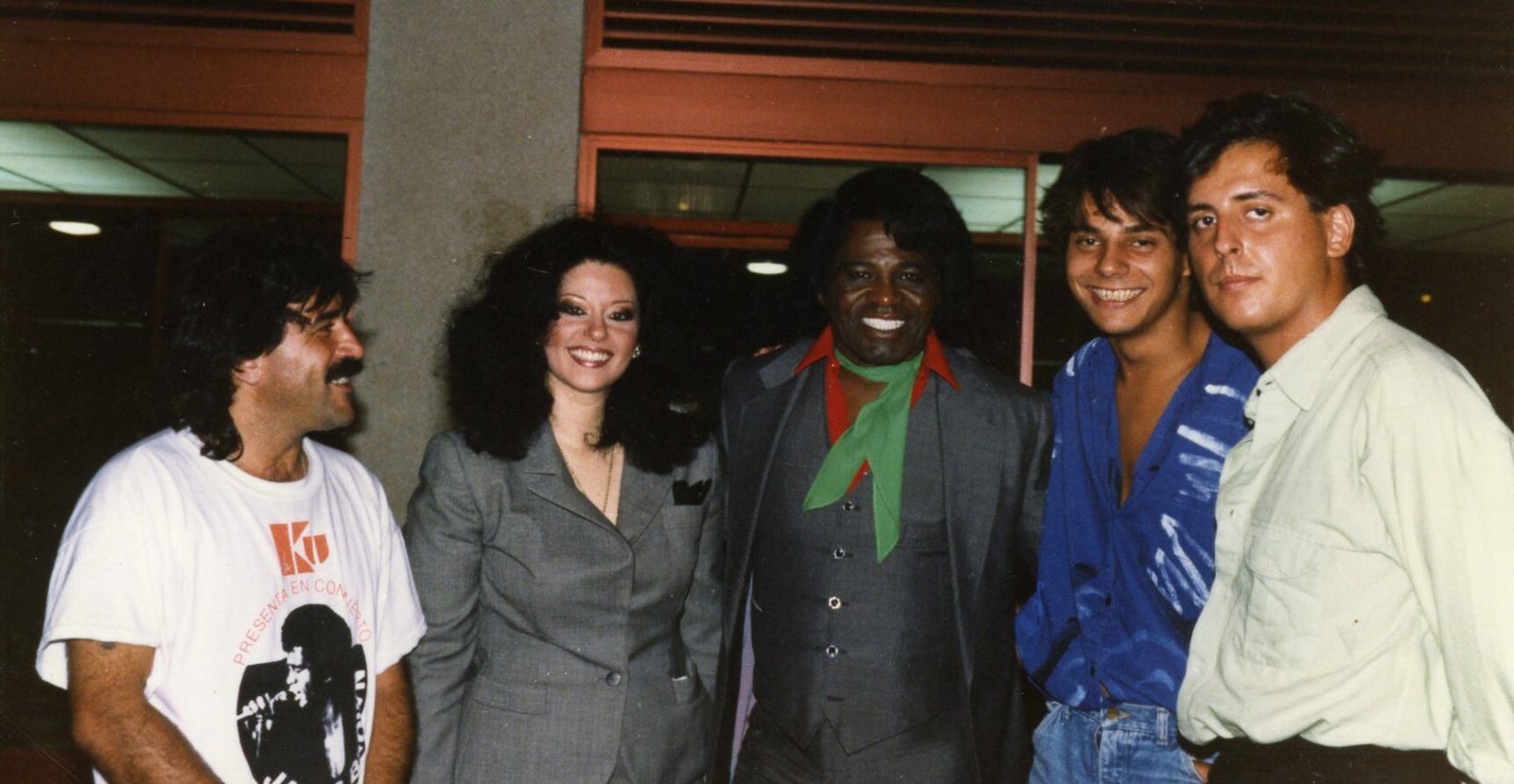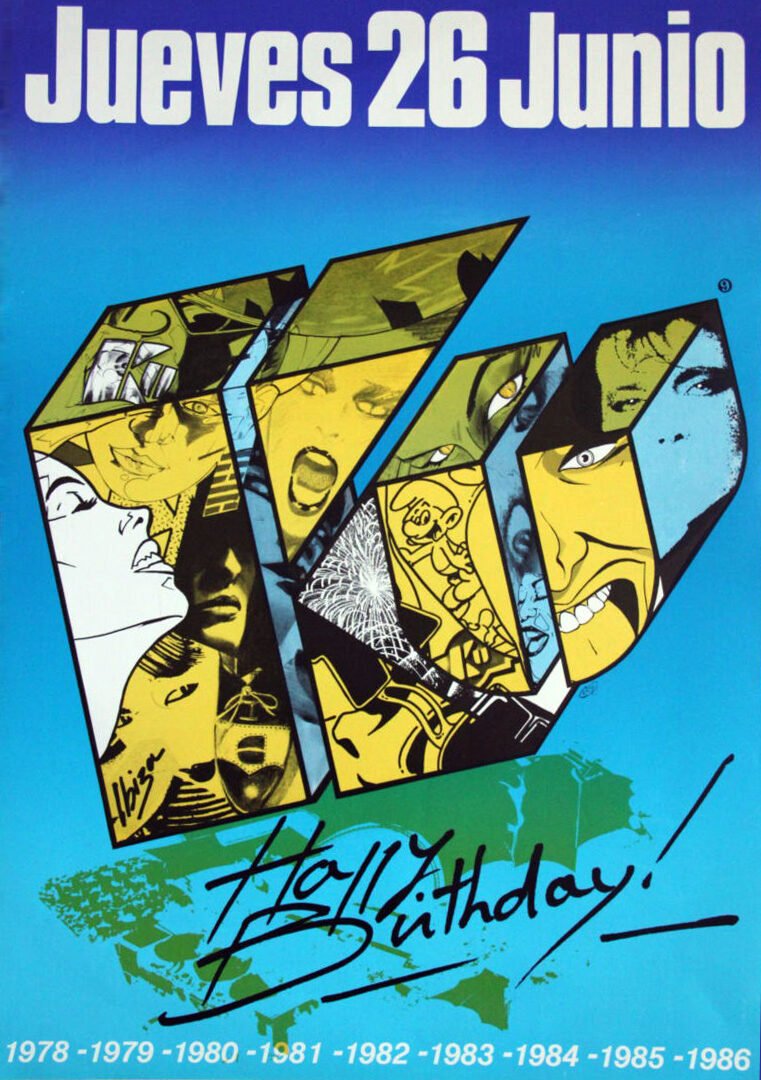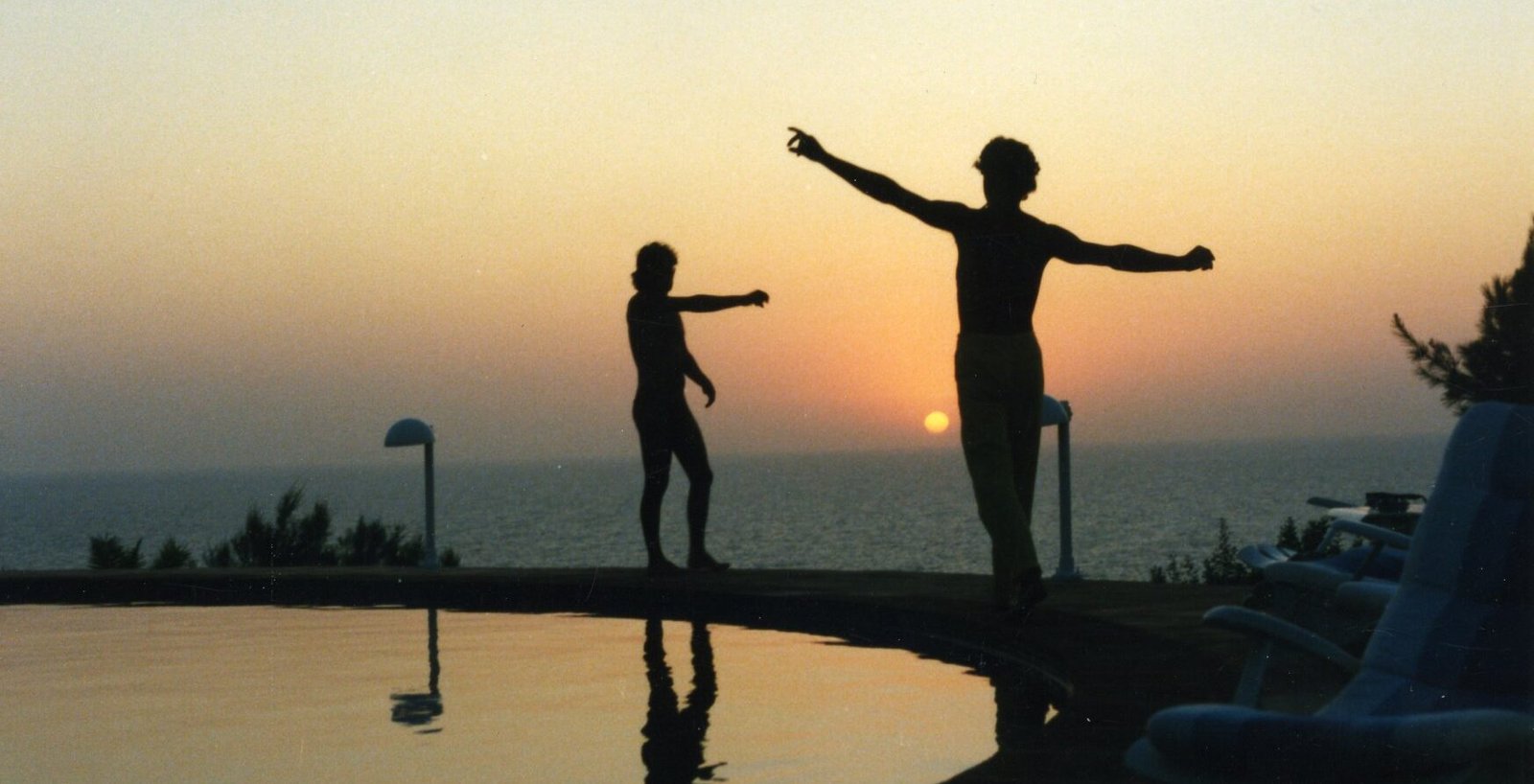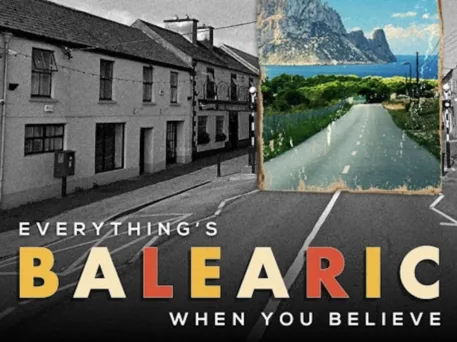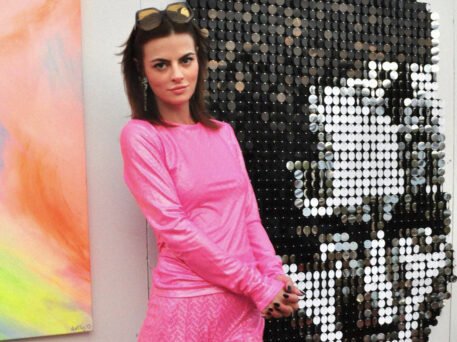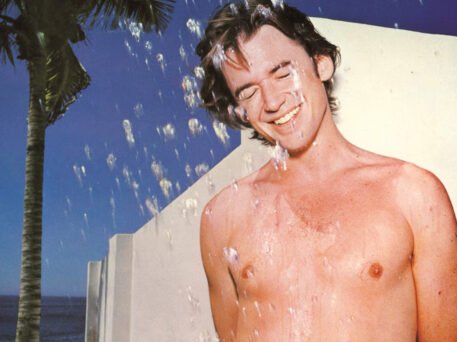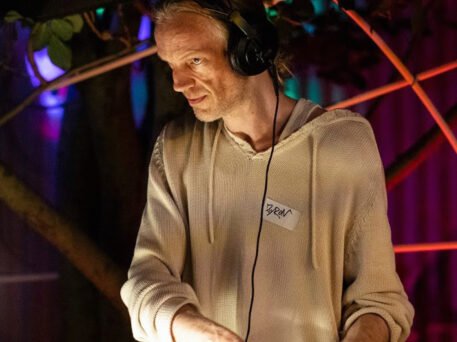The Electric Disco.
Gerardo Rubio at KU, 1985-1987
Gerardo Rubio tells us about his time spent working at KU during the clubs cosmopolitan heyday
Words by Mark Limb • May 16, 2024
Dressed up in Locomia's theme. Gerardo second from right.
Good evening Gerardo, thank you so much for taking time out to talk to us.
Can you introduce yourself for our readers and tell us how your relationship with Ibiza and KU came about.
I am Gerardo Rubio, I arrived in Ibiza in the spring of 1977 and I lived in Ibiza for about 10 years. When I arrived in Ibiza I realised that everything was so different and liberal that I decided to stay and live there.
In the summer of 1985 the publicity group at KU needed a giant doll and together with a sculptor friend, Paco, we decided to make them a giant dragon to take out into the street.
From that moment on I started to work for KU in the publicity team with Salus, until I left Ibiza in 1987.
Can you describe what it was like working at KU during this magical era?
During the day we would hand out posters in bars all over the island, to spread the word about the next party as there were three parties a week. We always gave away posters to everyone who asked for one.
We would go out on the streets by the port of Ibiza, dressed in KU’s clothes, giving stickers to everyone who passed by on the street. Two people were on stilts and carried a giant dragon which attracted a lot of people's attention.
"We would go out with banners and a powerful music system, which the KU DJs would record for us."
For us it was a lot of fun, because on the day of the party we went out dressed according to the party’s theme. There was a team of two in the wardrobe department who made the costumes and dressed us according to the theme of the night. We would then go out to the port of Ibiza with about 15/20 people.
We would go out with banners and a powerful music system, which the KU DJs would record for us. We carried some spotlights to illuminate us and when we went through the streets of the port it was a real show. Everyone would crowd around us from the moment we arrived at the port.
At KU there were 6 bars plus the restaurant and the shop. The most fun bar was the Coco Loco de Brasilio, where people dressed the most differently. Like the people from Locomía. Mondays were the days when the tourists from the hotels came.
The Coco Loco’s and caipirinhas were spectacular, that's all they served because that's what everyone wanted. But sometimes there were ‘special cocktails for friends of KU!
It was a gay bar and everyone dressed as freely as they pleased, some of them participated as contestants in the parties of ‘Miss Fantasia’, ‘Miss Universal’, ‘Babylonia’ and many others.
This bar used to always be full, even if there was no party that day.
The club parades around Ibiza town were truly spectacular when we arrived in Ibiza in the early 90’s. Was KU one of the first venues to adopt this approach?
Yes, KU was the first one to do this, no other club did such promotions during those years. In the first week of August there was the ‘Brazil’ party by Brasilio.
A float was mounted on a lorry and decorated like the floats of Rio de Janeiro, with a powerful sound system. Between 100 and 150 of us went out into the street for this, we all had dinner and drank coco locos beforehand.
It was such a success that the club was completely full, not only that day but the whole week. As a result, the management of KU decided to go out at every party and parade around the port of Ibiza to promote them.
Were you able to join the party at KU once the promotion for the evening was over?
Yes, because every night we ended up staying at KU. We had our own bar where we could invite everyone who came out with us on the street performances and everyone from the bars who let us put posters on their premises.
Inside the club we didn't have a specific job to do, we only had to attend to people who helped us in the promotion of KU.
"You could enjoy the full moon and see the sunrise with Ibiza town in the background."
Most of KU was still open air back then, as were many other famous venues on the island. How much do you think that affected the clubs atmosphere and appeal?
The wonderful thing about KU was that it had a magnificent outdoor garden with lots of plants and palm trees, where you could enjoy the full moon and see the sunrise with Ibiza town in the background.
Amnesia was a country house with its own garden and was also open air. Pachá was closed, but they made a terrace and extended it with open air spaces, as did Glory’s. Another one that was beautiful was Es Paradise in San Antonio. It had a water fountain that anyone could enjoy if things got too hot.
When these clubs had to be covered and ceased to be gardens, I think the magic was lost and the industrialisation of nightlife began.
The decor and architecture certainly made you feel like you were on the set of some kind of fantasy movie! Are there any particular features of the that stand out in your memory?
Every year there was something new and they never stopped improving the place. When they put up the marquees it was spectacular, as they were so tall.
They changed the shape of the pool and from the dance floor there was a glass wall where you could see people swimming, there was also a pyramid with a bar on the terrace at the back.
The restaurant was particularly good, as they had young Basque chefs who today are famous and have Michelin stars.
The building was also originally a restaurant and community swimming pool wasn't it. Did people still regularly swim in the pools?
Yes, it was a swimming pool with a bar in a development in San Rafael, there was also a squash court in the basement and a small gym. It was bought by Gorri, Santamaría and Javier Iturrioz, the three Basques who decided to invest in Ibiza.
The pool was always ready for a swim, day or night. Both staff and visitors could use it freely, but it wasn't open to the public as a swimming pool.
At KU there were about 70 to 80 people working there, and it was normal to take a bath when it was particularly hot.
From many of the early pictures I’ve seen it looks like the pool also provided the perfect backdrop for some of the themed nights that used to take place, such as the Tanga and Miss Waterfall parties.
Do you have any memories of these or any of the other themed parties that were held there?
There was a catwalk above the pool with a fountain in the middle that reached the stage, this was used to make all the parades of ‘Miss’.
We took part in ‘Underwear night’, which took place two days after the Brazil party. All of us who had been out on the street that night would go out on the catwalk to dance in our underwear with the fountain on, we would dance and jump into the pool and invite people to come out on the catwalk to dance.
"We would dance and jump into the pool and invite people to come out on the catwalk to dance"
For me the most spectacular theme night was ‘Miss wet t-shirt’. They paraded with the fountain on, the sound of the music filled the night and there were around 20 contestants, the shows lasted quite a long time.
There was the Hippy festival that turned into a street market with stalls. During San Fermín they would take out cows (like in Pamplona) to run around the club. In San Juan there was a bonfire in the car park with fireworks.
‘The last party’ was great because all the groups had to spend a few hours serving in the bars, so that the waiters could have their party. Drinks were always free that day until the party was over, but tips were welcome.
When I first visited KU, (much later in 1992), it felt like part of the magic was that everybody, no matter their background or status was dancing shoulder to shoulder. Was the concept of VIP much of a thing back then or did the separation come later?
KU already had its VIP bar upstairs with another doorman at the entrance, but many VIPs mixed with everyone else.
At that time VIPs were not given as much importance as they are now, or maybe they were not important to us because a lot of well-known people passed through. It was said that if you went to Ibiza and didn't go to the KU, you didn't really know what was going on in the island.
"That was the magic of the KU, anything was possible and we all mingled and participated in the party whether we were famous or not."
For example, one night Roman Polanski came (he was a regular) with Harrison Ford and Emmanuelle Seigner, who were shooting the film ‘Frantic’ in Paris. It was a normal night, but it happened to be Harrison Ford's birthday and they quickly prepared a ‘Congratulations’ sign with fireworks. We all sang happy birthday and they prepared a huge cake for all of us who were there.
That was the magic of the KU, anything was possible and we all mingled and participated in the party whether we were famous or not.
Was there always such a cosmopolitan and international appeal?
Well in the mid 80's the management at KU decided to make a magazine with photos of people who came, there was even a photographer. That magazine was distributed to a lot of people, and I think that gave KU a lot of glamour because there were many well-known people from Spain and Europe.
The names of Julio Iglesias, the Prince of Monaco, Angel Nieto and many others gave it a very important boost. Footballers, politicians, actors, singers, journalists, royalty like the current King of Spain and then the concerts.
In the Spanish media there was a lot of talk about Ibiza and KU, because it was something very different and exciting.
Live music also seems to have been a major part of KU's early years. Were you there for any of the famous concerts? Freddie Mercury & Montserrat Caballé for example?
Yes, I was at the ‘Ibiza 92’ concert where Freddy Mercury and Monserrat Caballé premiered the song ‘Barcelona’, exactly on May 28th 1987. At this festival also performed El Último de la Fila, Duran Duran, Maryllion, Chris Rea, Poison, Nona Hendrix and Spandau Ballet.
This festival was born thanks to the relationship of the KU management with Pino Sagliocco, who was a concert promoter with his company ‘Managers’. With the help of Televisión Española, ‘Managers’ started to bring live artists to KU. James Brown, Talk Talk, Kid Creole and the Coconuts, Nina Hagen, Sigue Sigue Sputnik and many others came to perform.
I especially remember the performance of James Brown, who was already a bit older and found it difficult to move. But when he came out on stage he was a whirlwind. He performed ‘Sex Machine’ and it was incredible, everybody in KU was dancing. These are memories I will never forget.
Our team always helped to bring the artists to the hotel and pick them up etc. We of course attended all the concerts.
Do you have any other memories of the music played during your time there? Were there any special records for you perhaps?
Music is what brings everything to life and it was always present in Ibiza. Every summer there were some songs that were very popular. For example:
Don't you forget about me - by Simple Minds
If You Love Somebody Set Them Free - from Sting’s album The Dream of the Blue Turtles, a smash hit in Ibiza that summer.
99 Red Balloons - by Nena
Living in A Box - By Living In A Box
What about the DJ’s? Can you remember who the residents were at the time?
Back then the DJs weren't as important as they are now, but they always did an excellent job of keeping the dance floor full. There was a group of New York dancers led by Venzee, which was the KU Break Dance Crew, who had their show on the dance floor with a DJ and sometimes did shows with us in Formentera.
This was the kind of music that was played early on. Then it was more Bowie, Talking Heads, New Order, Communards, Living in a Box etc...
On a separate note, in those years the Mediterraneo recording studios were opened and there were a lot of English bands that went to Ibiza to record their records, like Frankie Goes to Hollywood and Judas Priest.
"Then it was more Bowie, Talking Heads, New Order, Communards, Living in a Box etc..."
Yes I think the influence of Ibizan club culture became evident with a lot of the bands that came over to record there. New Orders Technique is another great example from a few years later.
Did you ever go to the studio or meet any of the bands that were there recording?
I was there a few times, as I knew the secretary and had some friends working in the hospitality side of the business. I knew Mariscal Romero, who was a Spanish producer who brought many bands to record at the studios.
Sometimes I was called to transport the music equipment and take it to the airport, but I never had the opportunity to see the studios in full. The musicians were quite reserved, they only wanted to work and rarely socialised.
You previously mentioned the magazine. I would imagine this helped KU to present itself to the world not only as a club but also as a brand.
Was there anything else KU was known for or involved in at the time?
Although we were not aware of this at the time, the magazine helped KU immensely. Now it’s what remains of those years.
On the other hand, the clothes shop that was above the restaurant was very successful because it had very daring models with vibrant colours. Many concerts and parties had their own T-shirts printed, as well as the popular KU tracksuit that we always wore.
Another hugely important part of the brand was Yves Uro's artwork which has become highly collectible in recent years. Did you realise how special his posters were at the time?
From the very first moment, I realised they were brilliant and unique. I could also tell by how popular they were when we handed them out on beaches and in bars. To the point that when we put them up in public places, we had to tear them up a bit so that they wouldn't be taken away.
I think they were very popular because they were from the KU and due to Uro's fantastic work. We didn't see Yves at KU very often, as he worked many hours and seemed to have a very personal life.
At KU, the staff didn't appreciate the posters as much and we often had leftovers that nobody wanted. Salus stored them in his car until there were so many that he wanted to throw them away. I told him I'd keep them in my car instead, and when nobody else showed any interest, I brought them with me when I left Ibiza.
Outside of your time spent at KU, what was life like in Ibiza during those early years?
In Ibiza you felt a freedom to do whatever you wanted, to dress as you liked, everything was possible and nobody bothered you. It was an invitation to participate in this mental and physical freedom that was not very usual in other places in Spain.
There was a mix of different people where we all fit in, it wasn't so important who you were, but what you brought to others.
At that time, clubs with very different music were opening around the port of Ibiza, in San Carlos, in San Antonio and on some beaches. It was a new way of daytime and night-time leisure, it was very different to anything that existed in Europe.
"There has been a mixture of people from all over the world coming to the island, who have coexisted with a great spirit of joy."
I imagine the decadence during this time was quite something to behold too!
I think perhaps in San Antonio as this was where the tourists went, groups of young Europeans would often try and drink as much as possible.
In Ibiza town people were positive and cheerful, KU had a similar atmosphere. There was obviously drinking and drugs, but people knew where to draw the line. It was all about having fun and I never saw any fights as everyone came to have a good time, in fact, there were very few people in security because it was not necessary.
Did you go to many of the other clubs at the time, such as Amnesia, Pacha or Glory’s?
When we finished at KU we used to go to Amnesia because it closed much later, that's when the matinée started.
We did go to Pacha, but not very often as we didn't have time. I also went to Glory's a couple of times before working at KU. We went to Amnesia very often, even though it wasn't at its best at the time.
What about further afield, was there anywhere else you might visit?
We would also go to the Dalias de San Carlos which sometimes had live music.
Dalias has become quite a popular tourist destination now hasn't it. What was it like back in the day?
Las Dalias was a bar for the locals in San Carlos, in the north-east and most hippy part of the island. They started having barbecues in the garden for tourists and when ‘Juanito de las Dalias’ took over, they started to organise concerts.
All the Spanish groups that recorded in the studio ‘Mediterráneo’ with Mariscal Romero ended up playing in Las Dalias, it became incredibly popular. People came from all over the island to see their concerts, including in winter.
They came up with the idea of organising a hippy market, which over the years has become very successful and is what it is known for today.
It feels like the years you spent in Ibiza and working at KU captured a very special moment in the island's history. Do you still visit now 40 years later, and if so how do you think things have changed?
I've been back to Ibiza several times, but I no longer find the Ibiza we lived in. It has changed considerably, now the parties are fixed, they are advertised on billboards, they take people there in buses. In other words, it's a total industrialisation of nightlife, where there's not much room for improvisation.
The Café del Mar is a beautiful bar, it had a fantastic atmosphere. When I see photos of the huge crowds that go now, I’m not sure I would enjoy it the same today.
It is also true that everyone thinks that their own time was the best and everyone has their own experiences. Ibiza is always interesting, but nowadays the nightlife industry is very important to its economy. I haven't been back to KU (privilege) since they covered it up, as I don't want to lose that image of a lively and fun garden.
Most friends that still visit the island regularly also tend to stay away from a lot of the places we used to frequent for the same reasons you mention…
I think it’s important to note that Ibiza not only has nightlife. It also has magnificent beaches such as Cala Conta or Aigües Blanques. You can enjoy the sea and its beaches with or without music.
A quiet life is also possible in the centre or north of the island, although less and less due to the number of houses that are being built. And let's not forget the markets of Es Caná and Las Dalias, which have given a lot of life to Ibiza’s creative community.
Ibiza, for those who have experienced it in any decade, is the best of times. In the sixties and seventies, a liberal line was set which the native inhabitants accepted. Since then, there has been a mixture of people from all over the world coming to the island, who have coexisted with a great spirit of joy.
You’re right and again that’s something that is echoed by pretty much everyone I speak to. I hope these places remain unspoiled for as long as possible and we can enjoy that quieter, more spiritual side of the island for years to come.
Gerardo, once again thank you so much for taking the time to talk to us.
We wish you all the very best.
Thank you very much for your interest.
Visit Gerardo's poster collection at ibizakuposters.com
Massive thanks to Noah Rubio for making this interview possible and for all your help translating our questions.
More like this
Mike Wilson of 100 Poems talks to us about his background, influences and the fantastic Everything is Balearic project
We spoke to Emma Salahi about her Ibiza based art gallery and the launch of the new Oriol Maspons superbook
Rob Butler chats to Californian legend Ned Doheny ahead of the re-release of three of his classic albums.
DJ Zyron aka Johan Åstrand talks to us about his background as a DJ, producer and record collector.
